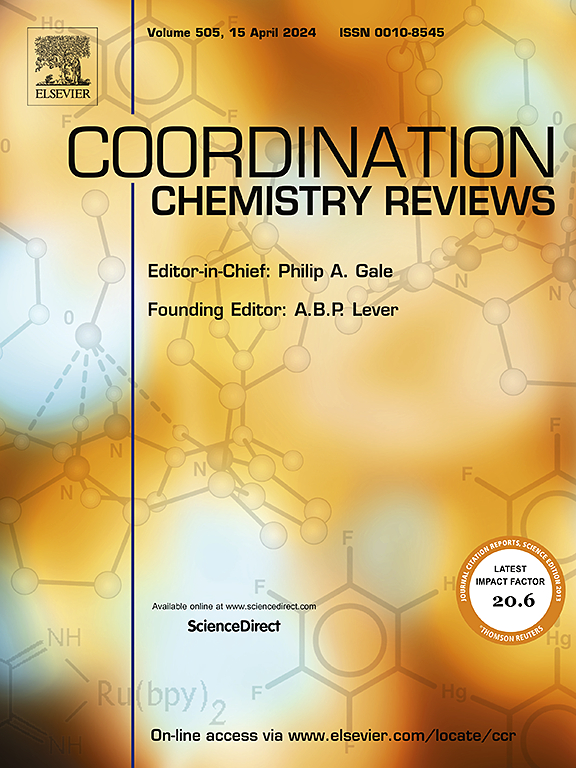Tailoring fluorescent probes for detecting COVID-19 virus in bio-samples and in vivo
IF 20.3
1区 化学
Q1 CHEMISTRY, INORGANIC & NUCLEAR
引用次数: 0
Abstract
The COVID-19 outbreak, caused by the SARS-CoV-2 coronavirus, has led to a global health crisis. The expeditious and dependable detection of SARS-CoV-2 is imperative for the efficacious control and management of the pandemic. Nevertheless, methods currently leveraged in clinical cases encounter notable challenges, encompassing elevated costs, protracted detection time, and vulnerability to false-positive outcomes, impeding the overall detection effectiveness. By comparison, fluorescent probes have become a promising tool in the diagnosis and monitoring of COVID-19 due to their high sensitivity, specificity, and real-time imaging capabilities. However, currently, there is no comprehensive review to expound upon the potential of fabricating fluorescent probes for COVID-19 detection. Under this objective, this review summarizes the applications of fluorescent probes in COVID-19 detection over the past three years. According to different detection targets, these probes are roughly divided into four categories: main protease, spike protein, nucleocapsid protein, and RNAs, and their response principles are well-described. Moreover, recent advancements in fluorescent probes for SARS-CoV-2 detection and their potential for clinical applications are also discussed. Overall, fluorescent probe-based detection technology presents promising prospects in the field of COVID-19 research, offering in-depth insights into the pathogenesis and facilitating the development of diagnostic tools and therapeutic strategies.

定制荧光探针用于检测生物样品和体内COVID-19病毒
由SARS-CoV-2冠状病毒引起的COVID-19疫情已引发全球卫生危机。快速、可靠地检测新冠病毒对于有效控制和管理疫情至关重要。然而,目前在临床病例中使用的方法面临着显著的挑战,包括成本高、检测时间长、易出现假阳性结果,阻碍了整体检测效率。相比之下,荧光探针由于其高灵敏度、特异性和实时成像能力,已成为新冠肺炎诊断和监测的一种有前景的工具。然而,目前还没有全面的综述来阐述制备用于COVID-19检测的荧光探针的潜力。本文综述了近三年来荧光探针在新型冠状病毒检测中的应用。根据检测目标的不同,这些探针大致分为主蛋白酶、刺突蛋白、核衣壳蛋白和rna四类,并对其响应原理进行了较好的描述。此外,还讨论了用于SARS-CoV-2检测的荧光探针的最新进展及其临床应用潜力。总体而言,基于荧光探针的检测技术在COVID-19研究领域具有广阔的前景,可以深入了解其发病机制,促进诊断工具和治疗策略的开发。
本文章由计算机程序翻译,如有差异,请以英文原文为准。
求助全文
约1分钟内获得全文
求助全文
来源期刊

Coordination Chemistry Reviews
化学-无机化学与核化学
CiteScore
34.30
自引率
5.30%
发文量
457
审稿时长
54 days
期刊介绍:
Coordination Chemistry Reviews offers rapid publication of review articles on current and significant topics in coordination chemistry, encompassing organometallic, supramolecular, theoretical, and bioinorganic chemistry. It also covers catalysis, materials chemistry, and metal-organic frameworks from a coordination chemistry perspective. Reviews summarize recent developments or discuss specific techniques, welcoming contributions from both established and emerging researchers.
The journal releases special issues on timely subjects, including those featuring contributions from specific regions or conferences. Occasional full-length book articles are also featured. Additionally, special volumes cover annual reviews of main group chemistry, transition metal group chemistry, and organometallic chemistry. These comprehensive reviews are vital resources for those engaged in coordination chemistry, further establishing Coordination Chemistry Reviews as a hub for insightful surveys in inorganic and physical inorganic chemistry.
 求助内容:
求助内容: 应助结果提醒方式:
应助结果提醒方式:


